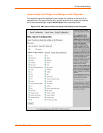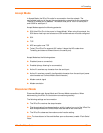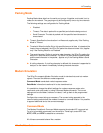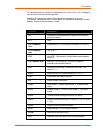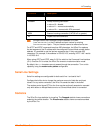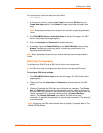
14 Tunneling
XPort Pro™ User Guide 130
Packing Mode
Packing Mode takes data from the serial port, groups it together, and sends it out to
nodes on the network. The groupings may be configured by size or by time intervals.
The following settings are configurable for Packing Mode:
Disabled
Timeout: The data is packed for a specified period before being sent out.
Send Character: The data is packed until the specified send character is
encountered.
Timeout: Specifies the time duration in milliseconds; applies only if the Packing
Mode is Timeout.
Threshold: When the buffer fills to this specified amount of data in bytes(and the
timeout has not elapsed), the XPort Pro packs the data and sends it out; applies
only if the Packing Mode is not Disabled.
The send character: Similar to a start or stop character, the XPort Pro packs the
data until it sees the send character. The XPort Pro then sends the packed data
and the send character in the packet. Applies only if the Packing Mode is Send
Character.
A trailing character: If a trailing character is defined, this character is appended to
data put on the network immediately following the send character.
Modem Emulation
The XPort Pro supports Modem Emulation mode for devices that send out modem
signals. There are two different modes supported:
Command Mode: sends back verbal response codes.
Data Mode: information transferred in is also transferred out.
It is possible to change the default settings for verbose response codes, echo
commands, and quiet mode, by using Command Mode commands. The current
settings can be overridden; however on reboot, it will go back to the programmed
settings.
Configure the connect string as necessary. The connect string appends to the
communication packet when the modem connects to a remote location. It is possible
to append additional text to the connect message.
Command Mode
The Modem Emulation’s Command Mode supports the standard AT command set.
For a list of available commands from the serial or Telnet login, enter AT?. Use
ATDT, ATD, and ATDP to establish a connection:
All of these commands behave like a modem.




